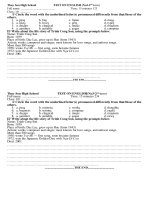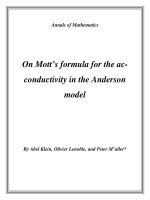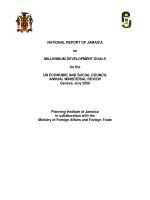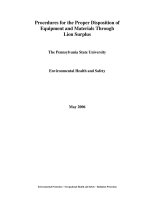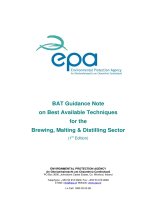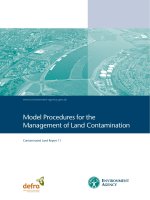MSC circ 1006 GUIDELINES ON FIRE TEST PROCEDURES FOR ACCEPTANCE OF FIRERETARDANT MATERIALS FOR THE CONSTRUCTION OF LIFEBOATS
Bạn đang xem bản rút gọn của tài liệu. Xem và tải ngay bản đầy đủ của tài liệu tại đây (31.23 KB, 6 trang )
INTERNATIONAL MARITIME ORGANIZATION
4 ALBERT EMBANKMENT
LONDON SE1 7SR
Telephone: 020 7735 7611
Fax:
020 7587 3210
Telex:
23588 IMOLDN G
E
IMO
Ref. T4/4.01
MSC/Circ.1006
18 June 2001
GUIDELINES ON FIRE TEST PROCEDURES FOR ACCEPTANCE OF
FIRE-RETARDANT MATERIALS FOR THE CONSTRUCTION
OF LIFEBOATS
1
The Maritime Safety Committee, at its seventy-fourth session (30 May to 8 June 2001), noted that
paragraph 4.4.1.4 of the International Life-Saving Appliance (LSA) Code as well as regulation VII/17 of
the Torremolinos Protocol of 1993 relating to the International Convention for the Safety of Fishing
Vessels, 1977 (1993 Torremolinos Protocol) uses the term “fire-retardant” with regard to materials for the
construction of the hull and rigid cover of lifeboats, but there is no definition of fire-retardant material either
in the LSA Code or in the 1993 Torremolinos Protocol.
2
The Committee, recalling that resolution 7 of the International Conference on Safety of Fishing
Vessels held in 1993 in Torremolinos invited the Committee to develop an appropriate definition of
fire-retardant materials together with the corresponding criteria related to the said definition as well as fire
test procedures aimed at assessing compliance with the criteria for such materials, approved Guidelines on
fire test procedures for acceptance of fire-retardant materials for the construction of lifeboats, as set out in
the annex.
3
Member Governments are invited to apply the annexed Guidelines when approving fire-retardant
materials used for the construction of lifeboats.
***
I:\CIRC\MSC\1006.doc
MSC/Circ.1006
ANNEX
FIRE TEST PROCEDURES FOR ACCEPTANCE OF FIRE-RETARDANT MATERIALS
FOR THE CONSTRUCTION OF LIFEBOATS
Application
1
This test procedure should be used for the acceptance of fire-retardant and flame-resistant materials
used for the construction of lifeboats which are required to be fire-retardant by the International Life-Saving
Appliances Code and the Torremolinos Protocol of 1993 relating to the International Convention for the
Safety of Fishing Vessels, 1977.
Fire test procedure
2
General
Ignitability for fire-retardant laminate systems for the construction of lifeboats should be determined by
ISO 5660-1: "Fire tests - Reaction to fire - Part 1: Rate of heat release from building products (Cone
calorimeter method)", as described in paragraph 3. This test should be conducted for each resin used.
In addition, a fire-retardant resin passing the test in paragraph 3 should undergo the test contained in
paragraph 4.
Fire-retardant test
3
Test specimens
Three test specimen laminates should be prepared reinforced with glass fibre of any form with a thickness of
5 mm and a minimum resin content of 40% by weight. Alternatively, three specimens of the specific
laminate system should be tested as built. When similar laminates of different thickness are used, the
minimum thickness should be tested. For laminates with normal thickness of greater than 50 mm, including
sandwich construction, the requisite specimens should be obtained by cutting away the unexposed face to
reduce the thickness to 50 mm. All specimens should be square with sides measuring 100 mm.
3.1
Conditioning of specimens
Before the test, the specimens should be conditioned in sunlight to 300 MJ/m2 (below 385 nm) of
natural UV radiation exposure of outdoor weathering or acceptable equivalent accelerated artificial
weathering exposure to the satisfaction of the Administration. Both natural and artificial exposures should
include elevated temperatures of at least 30°C for substantial periods of the exposure and 20 % wet time.
I:\CIRC\MSC\1006.doc
MSC/Circ.1006
ANNEX
Page 2
3.2
Test conditions
The test should be performed in the horizontal position using a specimen edge frame, and the irradiance to
the specimen during the testing should be kept constant. The test specimens should be tested to an
irradiance of 50 kW/m2.
3.3
Duration of tests
The test should terminate when ignition occurs in the test specimen or at 10 min.
3.4
Test results
The average ignition time should be calculated as the arithmetic mean of the ignition time of the three
specimens.
3.5
Acceptance criteria
The average ignition time should be greater than 40 s.
Flame-resistant tests
4.1
Test procedure
GRP laminates representing the lay-up of a prototype boat, which should be based upon the minimum hull
and/or canopy thickness to be used for the boat under consideration, should be tested to determine their
resistance to the effects of flame impingement and strength. The test specimen should be cut from a one
metre square panel of the above minimum thickness, which has been allowed to cure for not less
than 21 days and then stored for 30 days at ambient temperature as stated below. The test should be
carried out using the following methods:
.1
the heat source to conduct the fire test should be provided by a gas torch fitted with a
Sievert burner type No. 2944 or equivalent, giving a maximum flame temperature of
approximately 1,600°C and burning propane at the rate of 4,110 grams per hour with a
pressure of 0.2 MPa. During this procedure the rate of burning should be carefully
controlled, with the length of blue flame being approximately 200 mm to the point of the
greatest heat; and
.2
the centre of a 450 mm by 450 mm test sample, cut from the one metre square panel
(which should not be cut from the edges) should be exposed in the vertical plane
perpendicular to the gel-coat surface to the tip of the blue flame of the propane gas torch
for an initial period of one minute. This test specimen should be contained in a suitable steel
frame to prevent the spread of flame igniting the sample's edges. During this time,
observations of the heat effects on the specimen should be recorded.
I:\CIRC\MSC\1006.doc
MSC/Circ.1006
ANNEX
Page 3
4.2
Acceptance criteria
At the end of the one minute period, the burner should be removed and the area of flame impingement
should not support combustion more than 30 s after being removed from the burner.
4.3
Additional information
After completing the test specified in paragraph 4.1, the specimen should then be immediately re-exposed,
on the impingement point, by the heat source to establish the total burn-through time of the respective
lay-up. Total burn-through time is taken as flaming to appear on the unexposed surface.
Test report
5.1
5.2
The fire-retardant test report should include the following information:
.1
name of testing body;
.2
name of manufacturer of the material;
.3
date of supply of the materials and of tests;
.4
name or identification of the material;
.5
description of the material;
.6
density of the material;
.7
description of the specimens;
.8
test method;
.9
test results including all observations; and
.10
designation of the material according to the test criteria specified in paragraph 3.5.
The flame-resistant test report should include the following information:
.1
name of testing body;
.2
boat manufacturer;
.3
date of material test;
.4
boat type;
I:\CIRC\MSC\1006.doc
MSC/Circ.1006
ANNEX
Page 4
.5
description of the specimen;
.6
time for flame extinguishments;
.7
burn-through time; and
.8
designation of the material according to the test criteria specified in paragraph 4.2.
____________
I:\CIRC\MSC\1006.doc

